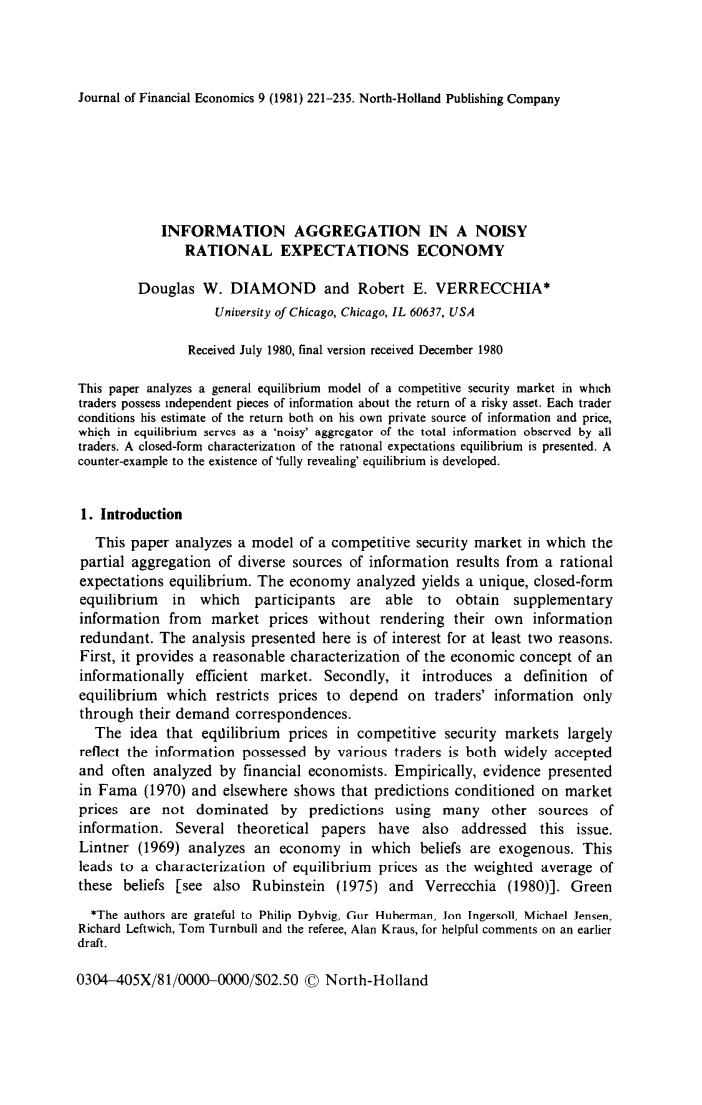正在加载图片...

Journal of Financial Economics 9(1981)221-235.North-Holland Publishing Company INFORMATION AGGREGATION IN A NOISY RATIONAL EXPECTATIONS ECONOMY Douglas W.DIAMOND and Robert E.VERRECCHIA* University of Chicago,Chicago,IL 60637,USA Received July 1980,final version received December 1980 This paper analyzes a general equilibrium model of a competitive security market in which traders possess independent pieces of information about the return of a risky asset.Each trader conditions his estimate of the return both on his own private source of information and price, which in equilibrium serves as a 'noisy'aggregator of the total information obscrved by all traders.A closed-form characterization of the rational expectations equilibrium is presented.A counter-example to the existence of 'fully revealing'equilibrium is developed. 1.Introduction This paper analyzes a model of a competitive security market in which the partial aggregation of diverse sources of information results from a rational expectations equilibrium.The economy analyzed yields a unique,closed-form equilibrium in which participants are able to obtain supplementary information from market prices without rendering their own information redundant.The analysis presented here is of interest for at least two reasons. First,it provides a reasonable characterization of the economic concept of an informationally efficient market.Secondly,it introduces a definition of equilibrium which restricts prices to depend on traders'information only through their demand correspondences. The idea that equilibrium prices in competitive security markets largely reflect the information possessed by various traders is both widely accepted and often analyzed by financial economists.Empirically,evidence presented in Fama (1970)and elsewhere shows that predictions conditioned on market prices are not dominated by predictions using many other sources of information.Several theoretical papers have also addressed this issue. Lintner (1969)analyzes an economy in which beliefs are exogenous.This leads to a characterization of equilibrium prices as the weighted average of these beliefs [see also Rubinstein (1975)and Verrecchia (1980)].Green *The authors are grateful to Philip Dybvig,Gur Huherman,Jon Ingersoll,Michael Jensen, Richard Leftwich,Tom Turnbull and the referee,Alan Kraus,for helpful comments on an earlier draft. 0304-405X/81/0000-0000/S02.50©North-HollandJournal of Financial Economics 9 (1981) 221-235. North-Holland Publishing Company INFORMATION AGGREGATION IN A NOISY RATIONAL EXPECTATIONS ECONOMY Chicago, Chicago, IL 60637, USA Received July 1980, final version received December 1980 This paper analyzes a general equilibrium model of a competitive security market in whtch traders possess independent pieces of information about the return of a risky asset. Each trader conditions his estimate of the return both on his own private source of information and price, which in equilibrium serves as a ‘noisy’ aggregator of the total information observed by all traders. A closed-form characterizatton of the rational expectations equilibrium is presented. A counter-example to the existence of ‘fully revealing’ equilibrium is developed. 1. Introduction This paper analyzes a model of a competitive security market in which the partial aggregation of diverse sources of information results from a rational expectations equilibrium. The economy analyzed yields a unique, closed-form equilibrium in which participants are able to obtain supplementary information from market prices without rendering their own information redundant. The analysis presented here is of interest for at least two reasons. First, it provides a reasonable characterization of the economic concept of an informationally efficient market. Secondly, it introduces a definition of equilibrium which restricts prices to depend on traders’ information only through their demand correspondences. The idea that equilibrium prices in competitive security markets largely reflect the information possessed by various traders is both widely accepted and often analyzed by financial economists. Empirically, evidence presented in Fama (1970) and elsewhere shows that predictions conditioned on market prices are not dominated by predictions using many other sources of information. Several theoretical papers have also addressed this issue. Lintner (1969) analyzes an economy in which beliefs are exogenous. This leads to a characterization of equilibrium prices as the weighted average of these beliefs [see also Rubinstein (1975) and Verrecchia (1980)]. Green *The authors are grateful to Philip Dybvig, Cur Huberman, Jon Ingersoll, Michael Jensen, Richard Lcftwich, Tom Turnbull and the referee, Alan Kraus, for helpful comments on an earlier draft. 0304405X/81/000&0000/$02.50 0 North-Holland